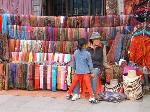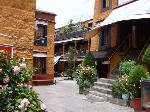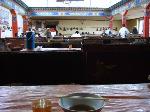- Getting around Lijiang. Dont stay in the Old Towns more than 2 days, there is nothing to do. KRISS Oct 9, 2013 05:46
- 2013 Beijing Temple Fair BENNYLAU Feb 26, 2013 03:29
- Malaysian traveling from KUL - LAX vis Shanghai PVG ZATI_DY Jan 3, 2013 20:15
Under Lhasa's spell
- Views: 5486
- |Vote: 2 1
- |Add to Favorites
- |Recommend to Friends
A stroll around the town
Being Tibet's capital city and it's cultural nucleus, Lhasa is a two-faced city, were charming alleys and courtyards give way to straight streets full of concrete communist blocks, and we're the silent dignity of devoted lines of Buddhists walking along the streets is disrupted by the hustle and noise of the tourist traffic.
Even though the sheer magic and mystery that Lhasa radiates is capable of making up for all these down points, it's up to us travelers to try to indulge ourselves in the life of this city without encountering and contributing too much to the non-picturesque sides of Lhasa.
I arrived in Lhasa late at night by train and after having found the perfect hotel very close to the Potala palace, I woke up the following morning feeling refreshed after the good sleep. I didn't have any plans for my days in Lhasa, other then taking it easy on the first two days as to avoid the occurrence of altitude sickness (which usually occurs about 8-10 hours after having arrived at a high place). So I decided to stroll around the city center a bit to enjoy the atmosphere and to make some plans for the following days.
First I walked past the mighty Potala Palace. Very often things that you've seen on pictures appear smaller when you finally see them in reality. Well, Potala is certainly the exception to that rule. It is grand! From Potala Square I walked along Beijing Street, through the big commercial Chinese-city-style shopping area to the old inner city quarters. After having visited so many Chinese cities in which the historic core is completely replaced by a modernistic cityscape, it was wonderful to walk trough the dense maze of alleys and tiny squares that make up Lhasa's old downtown. With the (bright!) sun on my face I enjoyed listening to the sound of the bells and vendors and inhaling the peculiar smell of yak.
The biggest square in Lhasa is of course the famous Barkhor square with the entrance to the Jokhang temple at the east side of it. This square is undoubtedly the place where all Tibet travelers come at one point during their trip. And the huge amount of souvenir stands is there to prove it! The street that circles Jokhang temple is not only a souvenir extravaganza, it's also a sacred circuit for Tibetan Buddhists. Therefore loads of traditionally dressed Tibetans mix with the browsing tourists along this atmospheric circular avenue.
A part of Lhasa's historic core that is often overseen by many tourist is the Islamic quarter to the east of the Barkhor/Jokhang area. Although the Tibetan architecture in this part of the city remains the same, this quarter notoriously differs from the rest of the city. Arabic looking signs, Islamic foods, a whole different range of shops and even a big mosque, give this area a unique feel and it's certainly worthwhile
.
Because I was enjoying the surroundings so much, I lost track of the time and also forgot to notice I had walked quite some miles by now, which I wasn't planning on doing because of the risk of altitude illness. I decided to sit down in one of the coziest traditional Tibetan cafes I could find, have my first try on milk tea and Tibetan noodles, and make plans for the following days.
Visiting the highlights
Of course everybody who visits Lhasa wants to enter the Potala Palace. In reality that is not as simple as it may seem. During the tourist peak season (roughly from May to October) there's only a limited number of visitors allowed to enter the palace on a daily basis. Moreover, most of the limited tickets are already sold beforehand to one of the many tour agencies. For a traveler who isn't joining an (expensive) group organized holiday tour of Tibet, there's only one possibility left and that is to go to the gate of Potala very, very early in the morning to purchase a scarce ticket for that day. And in fact; I went there one time at 8:00 o'clock and another time at 7:30 and both proved too late; the 'sold-out for the day' signs were already taped upon the ticket windows and gateways. If you're really keen on entering the Palace, there's always ticket dealers. Currently the real price of the ticket is 100RMB, but some ticket dealers will offer you one for about 500RMB. I didn't want to go in that badly (also because the time to look around the palace is limited to only one hour) but than a nice Tibetan lady I met, told me you can also only buy a ticket to enter the former royal village at the foot of the castle. This ticket is 30RMB and gives you access to the entire village within the palace walls and she said this was a much more enjoyable experience than a hasty visit to the palace itself during this peak days. And it certainly was enjoyable! The village that was formerly occupied by all kinds of royal staff, guildsmen and high ranking monks is currently being renovated back to its original state. It's now being transformed in a large open air museum, showcasing traditional Tibetan crafts, beautifully decorated interiors, cultural relics and several photo exhibitions about Tibet's transformation since the 1950s. Walking around the village is not only really interesting; it's relaxing too and you can easily spend have a day there, marveling over all the things presented and displayed. A sinister highlight is the former prison building where a multimedia exhibition with chilling sound effects and macabre relics make you feel if you stepped back in time.
Since the Potala complex is Tibet's no. 1 tourist attraction, the Chinese government carefully planned some parts of this exposition as a glorification of things the People's Republic has done for Tibet since they entered this area in the 1950s. Although I heard some Western people complain about the terrible hypocrisy of this part of the exhibition; I think it's a good chance to learn about the Chinese view on the 'Tibetan case' Because as we all know; every story has two sides…
Of course, you can not leave Lhasa without having visited some temples and monasteries. Although the ratio tourists/monks is about a 1000 to 1, Jokhang temple at the central Barkhor Square is a great place to visit. For me the best thing about the temple was the view from the roof; magnificent! The nicest monastery I visited in Lhasa's downtown area however, was the Tibetan Buddhist Nuns Monastery located in the southeast of the historic core. This monastery is occupied by female monks only, is beautifully preserved and has a courtyard that's nothing short of a flower sea [see picture] And between all these flower pots there is a good terrace where you can enjoy all kinds of traditional Tibetan drinks and snacks, after having visited the monastery's interior.
Just outside the Lhasa city borders are too big monastery complexes: Ganden and Sera. Although some travel agencies try to trick you into buying a tour to these places, but you can just as well take the public bus for 1RMB to the city's outskirts, followed by about a 15 minute walk. For both places, that's all it takes to reach them. It seems like the Sera Monastery is a bit more popular amongst tourist for the religious discussion amongst monks that takes place on a daily basis. I actually came in too late to watch this, but had a good time walking trough this Monastery which actually is more of a medium-sized village. The good thing about both Ganden and Sera is that they welcome you to walk and enter everywhere you like. And since both of these locations are built against mountain sides the views are fantastic!
Doing it authentic and cheap
It seems like some tourists think that Lhasa is a desolate and barren mountain village and they need to bring some kind of extended survival kit to survive there. In reality Lhasa is a medium-sized city with streets filled with all famous Chinese chain stores, there are several big supermarkets, there are fast food restaurants, western restaurants and on top of that hundreds of small stores filled with any travel item you might need during your stay in Tibet. Although these things are certainly not contributing to the beauty of Lhasa, they are convenient and if you really can't stand Tibetan cuisine you can always indulge in a Western, Nepalese or Indian feast.
Talking about Tibetan food; well, that's one of the few things of Tibet that most travelers aren't too enthusiastic about. And I have to say I can't blame them. Even for meat lovers, the taste of yak meat is something that they don't want to try regularly, but yak meat is basically the only thing there is. Well, there is also yak butter, yak cheese, yak milk and yak yoghurt but the peculiar taste and smell of the animal makes everything taste the same….like yak! I'm Dutch and therefore love cheese, but Yak cheese is really out my of league. Especially since it seems the taste of it sticks to your tongue for about three days after having eaten it. Not wanting to eat in non-local places, I ended up eating Tibetan noodles, yoghurt rice and sour baozi all my days there. On the other hand, it needs to be noted that Tibetan eat houses are more cozy then any Chinese restaurant ever will be. Low, cushioned couches, colorful decorations, the sweet smell of incense and sparse illumination make the places a joy to sit in. And since I found milk tea an absolute delicacy, I usually ordered an extra pot of it after my meal, so I could relax in this snug atmosphere a bit longer.
Just as Lhasa is developed city with regard to shopping and food options, it's also very easy to start all kinds of trips from Lhasa. The downtown area is filled with numerous travel agencies offering a wide range of travels. From 1 day trips to Namtso lake or Ganden Monastery, to multi-week travels to Everest and Nepal. As with all things in China; don't forget to bargain for everything you book at these travel agencies, even though it appears there prices are fixed. Some travel agencies offer fixed 1 day tours to certain locations during the peak season, which means the busses will depart every day, no matter the number of participants. The initial prices are a bit expensive (like 120 for a day tour to Namtso excluding meals, entrance fees etc.) but if you go the agencies around closing time, and they still have some empty seats left they're very willing to cut the price. I managed to get my ticket my ticket for Namtso for 80RMB, which is more reasonable considering the ancient bus they arranged for us.
Finally, getting out of Tibet is very easy too and can easily be arranged by your self instead of going to a travel bureau. Train tickets to Lhasa are notoriously hard to buy, but the other way around is fairly easy. Simply go to the ticket windows at the train station. For plane tickets go to the National Aviation branch office near the Potala Palace. Here all airlines are present and they'll offer you tickets for the best prices (in sharp contrast to the small bureaus) Also, there are airport busses leaving several times a day from the office entrance. The one hour trip to the airport is only 25RMB, while taxis charge you about 100 to 150. Good deals!
Having spent 4 fantastic days in Lhasa, I also decided to leave the city. Not without regret though; despite all the clearly visible results of 50 years of Chinese influence and increasing tourist popularity, it remains a city with an almost spellbinding appeal. Maybe in a few years I'll drop by again for another pot of milk tea…






 Copyright © 1998-2025 All rights reserved.
Copyright © 1998-2025 All rights reserved.
1.
Sep 12, 2007 04:28 Reply
ELLEN77 said:
A really down-to-the-earth description of Lhasa, quite pratical!
2.
Sep 10, 2007 03:46 Reply
JOANNEL said:
Hi Danny, i can smell that Yak Milk tea!! Great story and sounds lke a visit is worth it before it becomes too much more of a tourism town!
3.
Sep 7, 2007 04:00 Reply
FAERIEQUEENE said:
Thanks for the sequel you promised! A colourful Lhasa packed with useful travel infos and tips:)